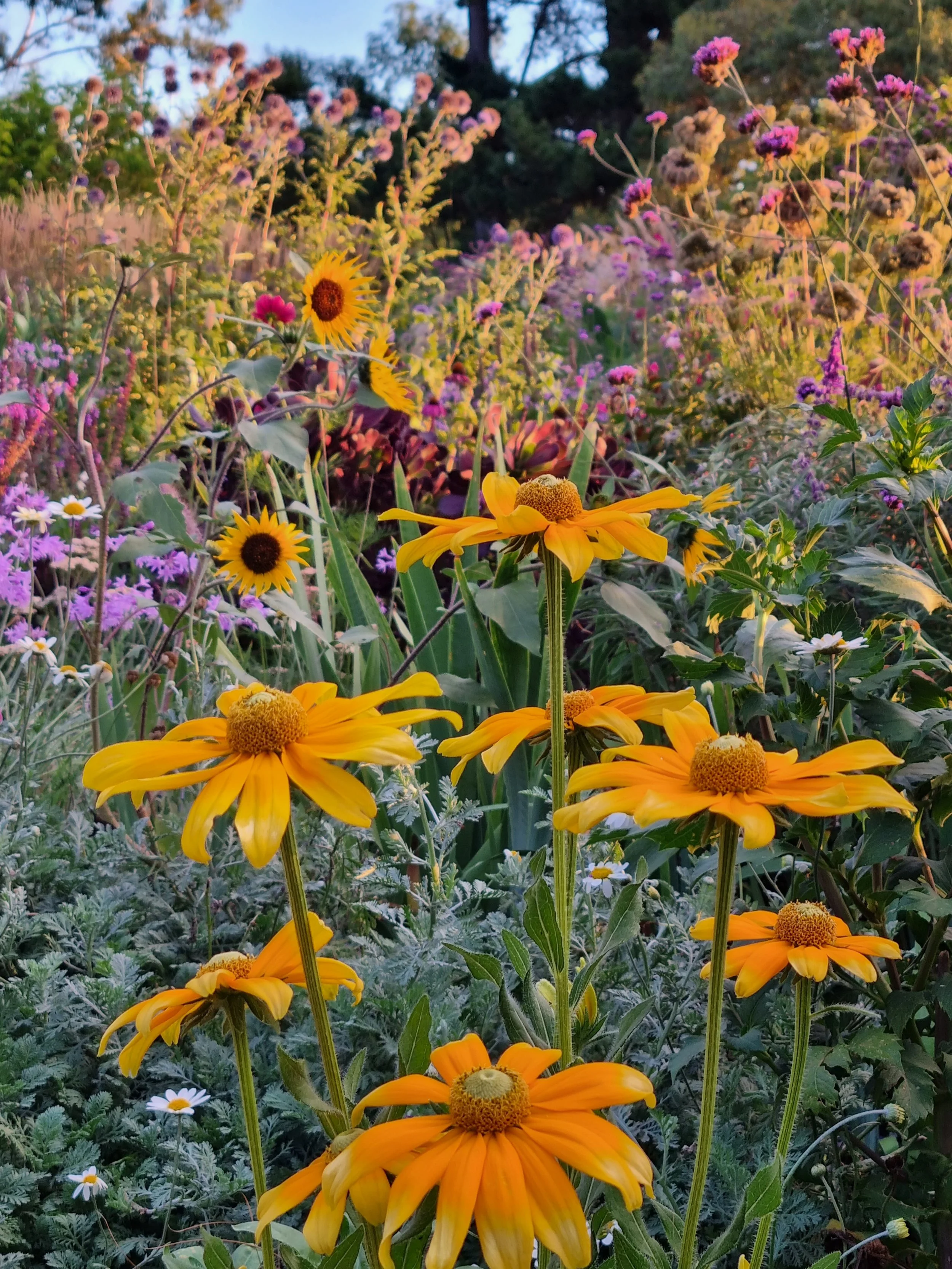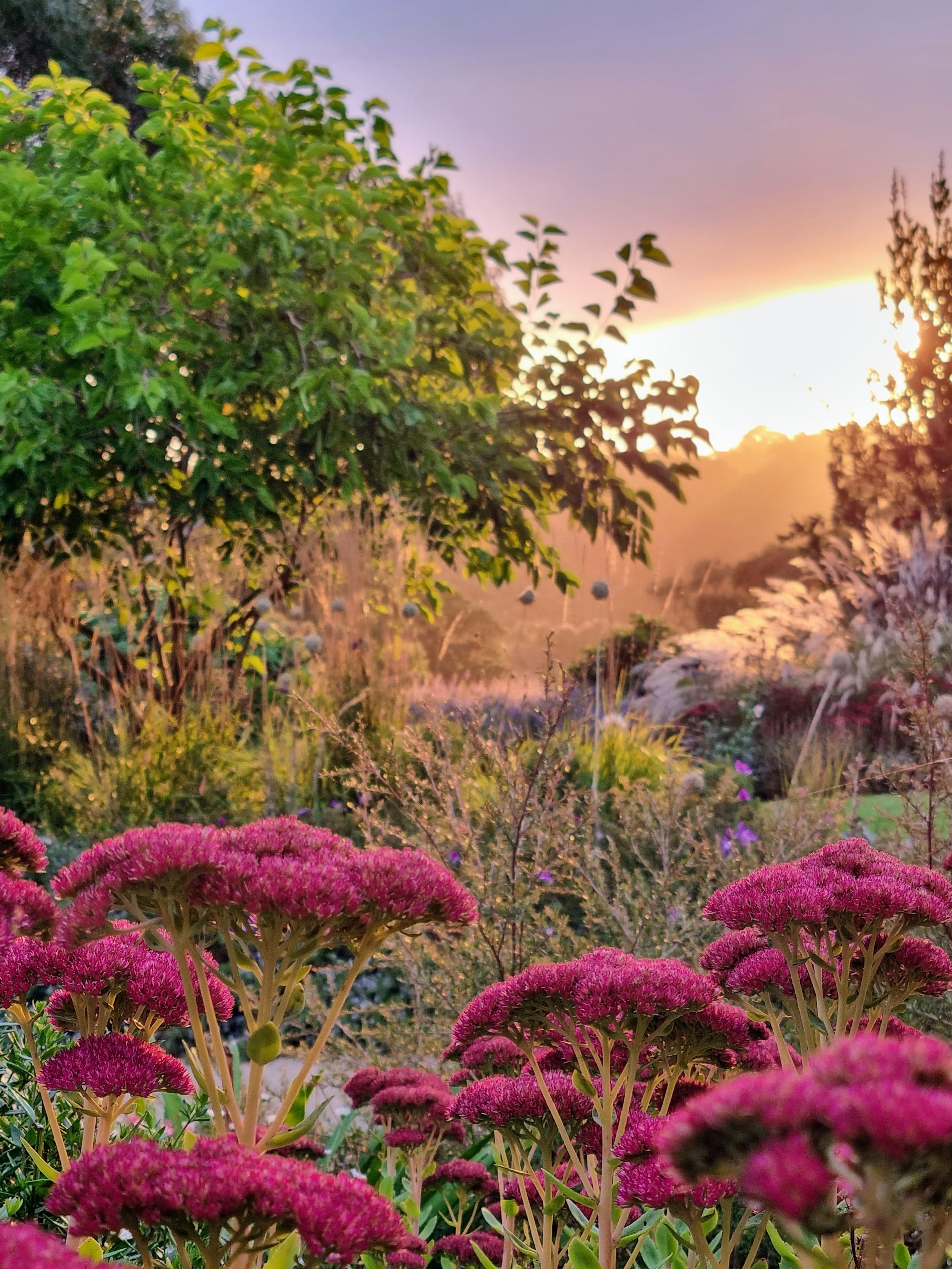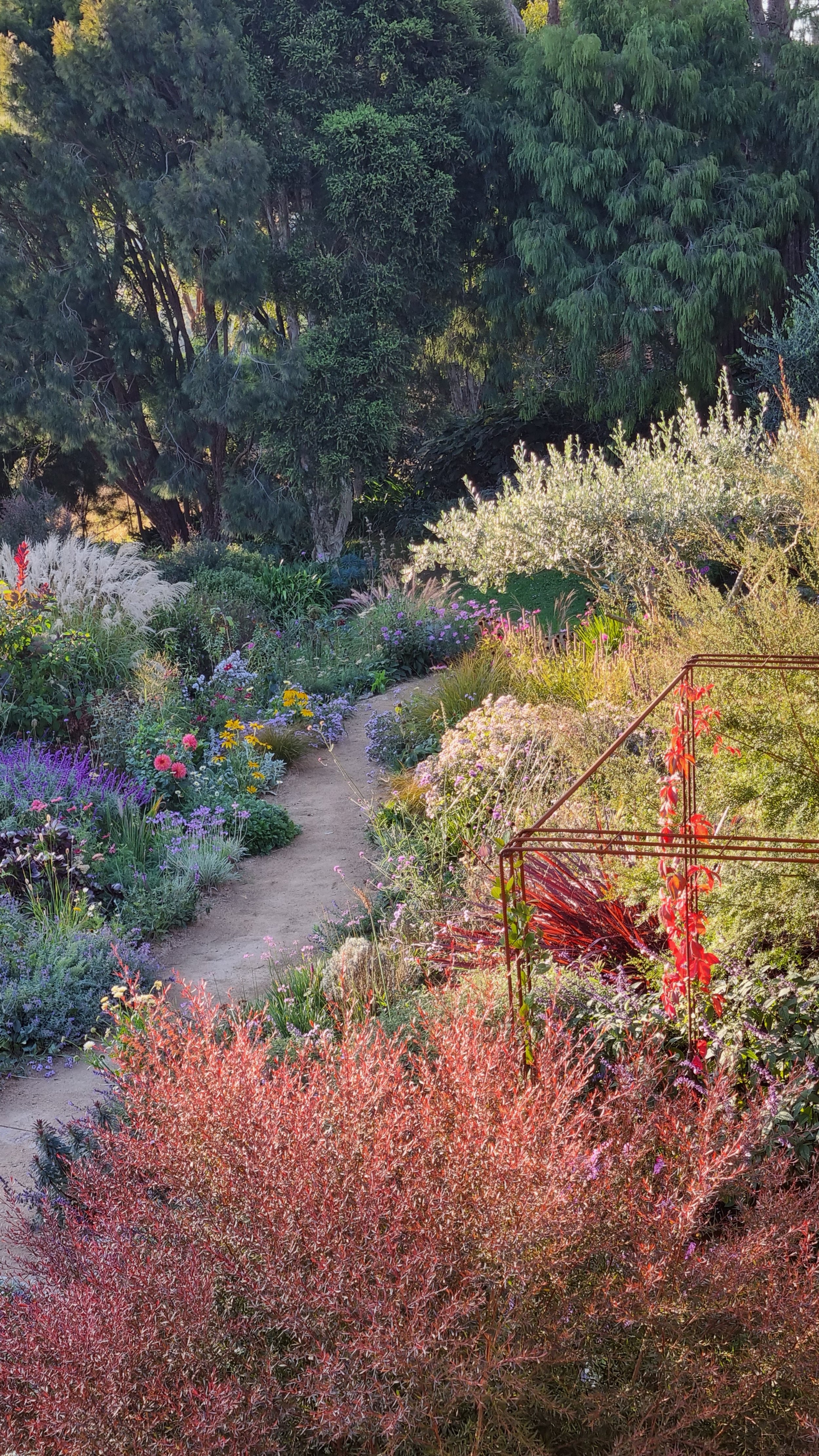AUSTRALIAN GARDEN : ANN-MAREE WINTER
Ann-Maree Winter’s garden - Summer 2023
The gardening world that exists with so much life and generosity on Instagram has expanded my own growing ideas exponentially.
I greedily follow gardens of all shapes and sizes from across the globe, finding intrigue and inspiration in the unique approach each person takes in crafting their own patch of ground.
It only took a glimpse of the first three images of Ann-Maree Winter’s Instagram feed for me to click follow. A half scroll down the page revealed square after square of plant-rich imagery that felt entirely up my alley. It was obvious I had stumbled on a passionate plantswoman in the pursuit of creating rich, textured tapestries that followed the seasons. I was hooked!
As I excitedly planned the content for Unearthed for the months ahead, Ann-Maree’s name hovered at the top of my list of Australian gardens that I wanted to share with you here. Her willingness to participate humbled me as did her informative and transparent
answers to all my questions.
I’m thrilled to share Ann-Maree’s garden in her own words, combined with a beautiful mix of imagery she has taken in documenting her garden of eight years through the seasons.
Julia xo
Garden profile
LOCATION: Arthurs Seat, Mornington Peninsula, Victoria, Australia
SIZE: Around 2 acres of garden.
ENVIRONMENT: The perennial garden has been created on sloping clay soil that faces west, exposed to the prevailing winds and hot afternoon sun in summer.
@annmaree.winter
We moved here in the autumn 2015 and it was obvious that the garden hadn’t been a loved one.
The first few months were taken up with weeding, removing plants and putting in specimens that I’d propagated in my previous tiny garden. The area (perennial garden which is mostly shared here) was initially a sloping expanse of lawn with three olive trees and a row of lomandras, punctuated by a couple of proteas and callistemons. It was a very dry year and I longed for the leafy oasis that I had made around our cottage in the suburbs, but I was way out of my depth and quite intimidated by what I had taken on.
Summer came around, the grass dried and the earth cracked, and I knew that I had to set about creating a protected microclimate around the house. What seemed like acres of gravel and crunchy grass meant that we were essentially living on a heated island on top of a hill! The previous owners had removed the wind-buffering Australian native plants to open up the view but, I felt that with a view from the deck, I was willing to sacrifice something to achieve my oasis. I wanted a windbreak that was lush, broad-leaved, hardy and fast-growing. I had seen and was inspired by a nearby open garden where Portuguese laurel was performing beautifully, so I adopted it as my choice.
My first early visions were for the colour and drama of a ‘hot border’ like the one that I loved at Heronswood Garden in Dromana. As I learnt more and was exposed to naturalistic approaches to garden design, my aspirations for the garden grew, claiming more lawn to create immersive plantings around circular ‘rooms’.
A central gravel path and connecting stairs take visitors on a journey of colour and texture within each space, but I’m also focused on the long view of the garden and ensuring that it flows. The garden has always peaked in summer so last year I planted poppies, sweet peas, dara, alliums, anemones and lilliums to create earlier seasonal interest. Whilst beautiful, the poppies crowded out and slowed the growth of the perennials, so this year I’ll just be allowing a few to grow where they have self-seeded.
SPRING 2021 - The circular garden now established with the protective hedge behind.
SPRING 2022 - The upper, retained circular grassed area.
EARLY SUMMER 2022 - Poppies (Papaver rhoeas ‘Amazing Grey’ ) and salvia (Salvia nemorosa ‘Amethyst’)
The hedge forms a spine, outside of which the plantings are Mediterranean in character and mostly fend for themselves. Within the hedge, it’s much cooler, and the plants and the smaller grassed area remain lush. Where the Portuguese laurels end and the view is opened to the borrowed landscape, the surrounding, more exposed beds have a whimsical, windswept character.
On summer evenings when the froth of perennials are bathed in mellow light, the garden is so much more than what I dared dream about in the early days. Honeyeaters flit between plants and parrots look like garden baubles. I dodge bees to trim the rosemary hedge, catching glimpses of butterflies but never achieving a clear photo - all of these creatures contribute to the joyful privilege of tending this garden.
In autumn, it’s that low light that skims across the garden, highlighting and casting shadows that adds a totally different dimension. The grasses shine and the evermore dramatic hues of the cotinus demand your attention as the branches flail about in the wind.
SPRING 2022 - The dry garden outside of the hedge with the bright spires of echium.
EARLY SUMMER - Kangaroo paw blending with perennials and succulents.
“On summer evenings when the froth of perennials are bathed in mellow light, the garden is so much more than what I dared dream about in the early days.”
EARLY SUMMER 2022 - The first summer for this stairway.
EARLY SUMMER 2022 - Lilium ‘Pink Giant’
DECEMBER 2022 - early summer dusk.
EXPERIENCE
Growing up I always loved to spend time with my mum in the garden and wherever I’ve lived, the garden has been the first focus of my attention. I tended a large collection of pots as a renter and, when we bought and settled in a lovely cottage in the suburbs, I joined The Diggers Club and developed my interest, in visiting open gardens. We packed a lot into our tiny garden but I dreamed of more space to garden.
Drought and water restrictions had claimed many plants in our suburban garden, so on moving to the new one, my focus turned to dry-tolerant planting that still felt joyful and colourful. I wanted to learn more about native Australian plants to revitalise the tired beds in front of the new house and to create a garden that was climate appropriate.
Early on I had help with the basics of clearing, mowing and weeding but I hoped to find a gardener with knowledge of the perennials I hoped to use. I found this in Julie Willis who had a wealth of experience in the UK and here, at Heronswood (preserved by The Diggers Club). She was kind enough to join me in late 2018, working in a symbiotic garden partnership in my own garden. We talked over ideas, discussing plants and design while tending to my ever-expanding garden. Over the years, with Covid and her other commitments, we haven’t maintained a regular, weekly session but that early foundation and the confidence that was instilled by having my ideas and vision encouraged by a gardener of Julie’s calibre, have been of huge benefit.
SUMMER 2022 - (see the ‘before’ image in the gallery at the top of feature)
SUMMER 2023 - An eye popping collection of shapes with echinacea, agastache, achillea and helenium amongst others!
SUMMER 2023 - Echinacea pallida
SUMMER 2023 - Echinops in the foreground of fabulously interesting plant and bloom shapes of the summer show.
LATE SUMMER 2023 - cosmos in the foreground
SPECIAL CONSIDERATIONS
The aspect of the perennial garden, with its slope and clay, has been my greatest consideration when creating this garden. The formation of levels and zones within the space has allowed me to choose plants that I hope will work in those specific sites. As we were doing a lot of the early work of establishing these beds during lockdowns and working around existing underground plumbing, everything had to be manually created. This did have the added bonus of not compacting the soil any further.
I now have areas that hold more moisture, where I can trial thirstier plants, and the drier sloped beds are well suited to the drought-tolerant plants. We manage on tank water so mulching is essential. I alternate between compost and pea straw for the perennials whilst in the mostly native front garden, I use the mulch from all of the tree work that we have done.
Along the way, I seem to have created the perfect environment for bush rats who burrow through the undergrowth and devour the roots of favoured plants! All we can do is cave in the tunnels, and remove plants like arthropodiums and panicums, instead replacing them with other grasses. With a vision of a sea of purple spheres, I planted out 40 bulbs of Allium ‘Purple Rain’ but it appears that they were delicious as well!
EARLY AUTUMN 2023 - looking down from the deck.
“In autumn, it’s that low light that skims across the garden, highlighting and casting shadows that adds a totally different dimension. The grasses shine and the evermore dramatic hues of the cotinus demand your attention as the branches flail about in the wind”
EARLY AUTUMN 2023 - Rudbeckia
EARLY AUTUMN 2023 -A year after converting this area from lawn and beds, to a narrow gravel path with widened gardens
AUTUMN 2023 - Giant garlic and Calamagrostis ‘Karl Foerster’
EARLY AUTUMN 2023
STAND OUT PLANTS
While we have focused on the perennial garden in this article, some of my favourite plants are in my native garden.
I have two waratahs that give me so much joy, as do the old man banksias at the top of our paddock. Diggers speedwell has a wonderful, weeping habit and delicate lavender flowers that are equally at home with natives and exotics.
Its late autumn now, and the stars of the show in my perennial garden have been Sedum ‘Autumn Joy’, Calamagrostis x acutiflora ‘Karl Foerster’, Miscanthus sinensis ‘Kleine Fontane’ and Miscanthus transmorrisonensis. Salvia semiatrata is truly lovely and so tough. Cotinus coggygria ‘Grace’ and ‘Flame’ are so valuable in a garden whose windy aspect has claimed a number of deciduous trees. The ginkgo is also resilient and spectacular in autumn.
Over the past, very mild spring and summer I have had so many highlights!
Papaver rhoeas ‘Amazing Grey’ (poppy) worked well with everything but especially with Lathyrus odorata ‘Almost Black’ (sweet pea). While my Allium ‘Purple Rain’ was also lovely, the Allium sphaerocephalum drumstick alliums proved to not be so appealing to mice and were just so whimsical, as were the bobbing heads of Allium ampeloprasum Russian garlic.
Lilium ‘Pink Giant’ was stunning and definitely a favourite being the most versatile of the colours that I tried. The combination of magenta and orange in Agastache ‘Sweet Lili’ allows it to blend with warm and cool colour schemes and it has performed well in my garden over a number of years. Agastache ‘Blue Fortune’ is a wonderful vertical accent when paired with echinacea. I have varieties of Echinacea pallida, purpurea as well as cream-coloured echinacea - all of which have self-seeded freely in my garden.
Echinops ritro ‘Veitch’s Blue’ were new to the garden this past year and I couldn’t get enough of their perfect spheres held atop of strong, tall plants. While many of my dahlias didn’t perform well for me this year, ‘Café au Lait’ was gobsmackingly gorgeous and I had some nice surprises with the single, dark-leafed dahlias, grown from seed. Cosmos atrosanguineus chocolate cosmos has been a standout for months, looking wonderful with Carex comans Bronze New Zealand hair sedge and Rudbeckia ‘Sahara’.
Salvia nemorosa varieties are all lovely but ‘Amethyst’ is a favourite as the colour is so versatile. The bronze accents of Persicaria amplexicaulis ‘White Eastfield’ created a subtle haze with heleniums and Cosmos ‘Rubenza’, while Persicaria ‘Fascination’ was a delicate foil for the exuberance of Café au Lait. Finally, Lepechinia salviae was the perfect combination of dusky, maroon flowers and large, grey-green leaves to anchor a vibrant colour scheme and in contrast to the finer-leafed perennials and grasses.
AUTUMN 2023
AUTUMN 2023 - the salvia spires electrifying the stairway
AUTUMN 2023
AUTUMN 2023 - Cotinus ‘Flame’ in the foreground
ADVICE FOR NEW GARDENERS
This garden has been created by learning as we go, one project at a time. As a result, each space that we have made has helped us, as amateurs, to visualise what might come next - an informed, natural progression that could not have been achieved had I tried to map the whole garden out 8 years ago. As I have gardened, my plant palette and aesthetic considerations have developed. So my advice to new gardeners is to read, research and visit open gardens.
Find inspiration and keep up with current thinking via Instagram, following the learning paths that emerge from there. Get a feel for what sings for you but be realistic about your climate and site and don’t persist with unhappy plants. Perhaps give them a chance in another position before giving up entirely but accept that you will kill plants to learn. With so much inspiration, it’s easy to be overwhelmed so break the big ideas into manageable areas and try to finish before moving on.
The vibrant heads of Sedum ‘Autumn Joy’
LATE AUTUMN 2023
“As I have gardened, my plant palette and aesthetic considerations have developed. So my advice to new gardeners is to read, research and visit open gardens.”
AUTUMN VIEW FROM THE DECK.
LATE AUTUMN 2023 - Late season texture
ANN-MAREE’S SOURCES OF INSPIRATION
READING
Claire Takacs’s books are beautiful and so inspiring. If I were to choose one it would be ‘Wild’.
The Gardeners Palette: Creating Colour Harmony in the Garden by Jo Thompson
Planting: A New Perspective by Piet Oudolf and Noel Kingsbury
At Work by Piet Oudolf
Native - Art and Design with Australian Plants by Kate Herd
Gardens Illustrated magazine (UK based)
READING ONLINE
The Gardenist blog, Michael McCoy
The Garden Curator - newsletter and Instagram account @thegardencurator by Colleen Southwell
WATCHING
Garden Masterclass on Youtube
BBC Gardeners World - accessed on mainstream TV networks or other depending where you live in the world!
INSTAGRAM
Provided links to plants are chosen by Julia with no bias - simply to connect with the best imagery and information
to aid the reader on that plant.
No affiliate or sponsored links are included - please beware they may contain some seasonal information from other countries that differ from the one you are in!

































